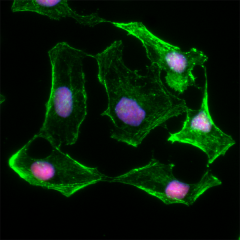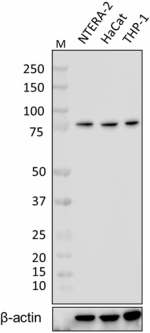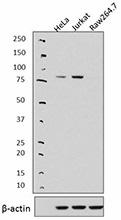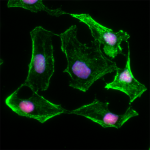- Clone
- 3E4 (See other available formats)
- Regulatory Status
- RUO
- Other Names
- Structure specific recognition protein 1 (SSRP1), Facilitates Chromatin Transcription 80 kD subunit, FACTp80, Recombination signal sequence recognition protein
- Isotype
- Mouse IgG1, κ

-

HeLa cells were fixed with 1% paraformaldehyde (PFA) for ten minutes, permeabilized with 0.5% Triton X-100 for ten minutes, and blocked with 5% FBS for 30 minutes at room temperature. Then the cells were intracellularly stained with 2.5 µg/ml anti-SSRP1 (clone 3E4) Alexa Fluor® 647 (red) in blocking buffer overnight at 4°C, followed by phalloidin staining (green) for 20 minutes. Nuclei were counterstained with DAPI (blue). The image was captured with a 40X objective.
| Cat # | Size | Price | Quantity Check Availability | ||
|---|---|---|---|---|---|
| 609808 | 100 µg | $358.00 | |||
SSRP1 is a nuclear protein and a component of the FACT complex (facilitates chromatin transcription). The FACT140 complex is composed of the Spt16 and the SSRP1 proteins. This complex interacts with nucleosomes and histone H2A/H2B dimers to promote nucleosome disassembly and allow transcription elongation. This protein interacts with dsDNA. The SSRP1 protein has been shown to be modified by cisplatin and may protect DNA from repair and block DNA replication. The 3E4 monoclonal antibody recognizes human SSRP1 and has been shown to be useful for Western blotting.
Product Details
- Verified Reactivity
- Human
- Antibody Type
- Monoclonal
- Host Species
- Mouse
- Immunogen
- Recombinant (partial)
- Formulation
- Phosphate-buffered solution, pH 7.2, containing 0.09% sodium azide.
- Preparation
- The antibody was purified by affinity chromatography and conjugated with Alexa Fluor® 647 under optimal conditions.
- Concentration
- 0.5 mg/ml
- Storage & Handling
- The antibody solution should be stored undiluted between 2°C and 8°C, and protected from prolonged exposure to light. Do not freeze.
- Application
-
ICC - Quality tested
- Recommended Usage
-
Each lot of this antibody is quality control tested by immunocytochemistry. For immunocytochemistry, a concentration range of 0.1 - 10 μg/ml is recommended. It is recommended that the reagent be titrated for optimal performance for each application.
* Alexa Fluor® 647 has a maximum emission of 668 nm when it is excited at 633 nm / 635 nm.
Alexa Fluor® and Pacific Blue™ are trademarks of Life Technologies Corporation.
View full statement regarding label licenses - Excitation Laser
-
Red Laser (633 nm)
- Application Notes
-
This clone is not recommended for ChIP (Chromatin Immunoprecipitation) assays (as determined by in-house testing).
-
Application References
(PubMed link indicates BioLegend citation) -
- Tan B C-M, et al. 2006. EMBO doi:10.1038/sj.emboj.7601271
- RRID
-
AB_2566301 (BioLegend Cat. No. 609808)
Antigen Details
- Structure
- SSRP family, HMG box domain; 81 kD
- Distribution
-
Nuclear
- Function
- Interacts with nucleosomes and histone H2A/H2B dimers to promote nucleosome disassembly and allow transcription elongation, binds to dsDNA. Modified by cisplatin, may protect DNA from repair and block DNA replication
- Interaction
- Component of FACT ATP-dependent chromatin remodeling complex, Spt16/Cdc68 in FACT complex, H2A/H2B dimers
- Biology Area
- Cell Biology, Chromatin Remodeling/Epigenetics, DNA Repair/Replication, Transcription Factors
- Antigen References
-
1. LeRoy G, et al. 1998. Science 282:1836.
2. Orphanides G, et al. 1998. Cell 92:105.
3. Orphanides G, et al. 1999. Nature 400:284. - Gene ID
- 6749 View all products for this Gene ID
- UniProt
- View information about SSRP1 on UniProt.org
Other Formats
View All SSRP1 Reagents Request Custom Conjugation| Description | Clone | Applications |
|---|---|---|
| Purified anti-SSRP1 | 3E4 | WB,ICC,IP |
| Alexa Fluor® 647 anti-SSRP1 | 3E4 | ICC |
Compare Data Across All Formats
This data display is provided for general comparisons between formats.
Your actual data may vary due to variations in samples, target cells, instruments and their settings, staining conditions, and other factors.
If you need assistance with selecting the best format contact our expert technical support team.
-
Purified anti-SSRP1

Total cell lysates (15 µg total protein) from NTERA-2, HaCat... 
15 µg of total protein extract from indicated cells was reso... 
HeLa cells were fixed with 1% paraformaldehyde (PFA) for ten... -
Alexa Fluor® 647 anti-SSRP1

HeLa cells were fixed with 1% paraformaldehyde (PFA) for ten...
